Audio Super Resolution
Audio super resolution is the process of enhancing the quality of audio signals by increasing the sampling rate or frequency.
Papers and Code
Towards General Modality Translation with Contrastive and Predictive Latent Diffusion Bridge
Oct 23, 2025Recent advances in generative modeling have positioned diffusion models as state-of-the-art tools for sampling from complex data distributions. While these models have shown remarkable success across single-modality domains such as images and audio, extending their capabilities to Modality Translation (MT), translating information across different sensory modalities, remains an open challenge. Existing approaches often rely on restrictive assumptions, including shared dimensionality, Gaussian source priors, and modality-specific architectures, which limit their generality and theoretical grounding. In this work, we propose the Latent Denoising Diffusion Bridge Model (LDDBM), a general-purpose framework for modality translation based on a latent-variable extension of Denoising Diffusion Bridge Models. By operating in a shared latent space, our method learns a bridge between arbitrary modalities without requiring aligned dimensions. We introduce a contrastive alignment loss to enforce semantic consistency between paired samples and design a domain-agnostic encoder-decoder architecture tailored for noise prediction in latent space. Additionally, we propose a predictive loss to guide training toward accurate cross-domain translation and explore several training strategies to improve stability. Our approach supports arbitrary modality pairs and performs strongly on diverse MT tasks, including multi-view to 3D shape generation, image super-resolution, and multi-view scene synthesis. Comprehensive experiments and ablations validate the effectiveness of our framework, establishing a new strong baseline in general modality translation. For more information, see our project page: https://sites.google.com/view/lddbm/home.
UniverSR: Unified and Versatile Audio Super-Resolution via Vocoder-Free Flow Matching
Oct 01, 2025In this paper, we present a vocoder-free framework for audio super-resolution that employs a flow matching generative model to capture the conditional distribution of complex-valued spectral coefficients. Unlike conventional two-stage diffusion-based approaches that predict a mel-spectrogram and then rely on a pre-trained neural vocoder to synthesize waveforms, our method directly reconstructs waveforms via the inverse Short-Time Fourier Transform (iSTFT), thereby eliminating the dependence on a separate vocoder. This design not only simplifies end-to-end optimization but also overcomes a critical bottleneck of two-stage pipelines, where the final audio quality is fundamentally constrained by vocoder performance. Experiments show that our model consistently produces high-fidelity 48 kHz audio across diverse upsampling factors, achieving state-of-the-art performance on both speech and general audio datasets.
Ambisonics Super-Resolution Using A Waveform-Domain Neural Network
Aug 01, 2025Ambisonics is a spatial audio format describing a sound field. First-order Ambisonics (FOA) is a popular format comprising only four channels. This limited channel count comes at the expense of spatial accuracy. Ideally one would be able to take the efficiency of a FOA format without its limitations. We have devised a data-driven spatial audio solution that retains the efficiency of the FOA format but achieves quality that surpasses conventional renderers. Utilizing a fully convolutional time-domain audio neural network (Conv-TasNet), we created a solution that takes a FOA input and provides a higher order Ambisonics (HOA) output. This data driven approach is novel when compared to typical physics and psychoacoustic based renderers. Quantitative evaluations showed a 0.6dB average positional mean squared error difference between predicted and actual 3rd order HOA. The median qualitative rating showed an 80% improvement in perceived quality over the traditional rendering approach.
Audio-Assisted Face Video Restoration with Temporal and Identity Complementary Learning
Aug 06, 2025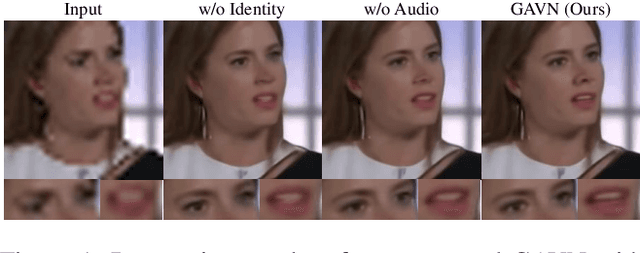
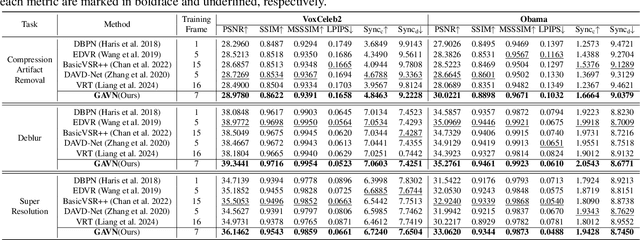
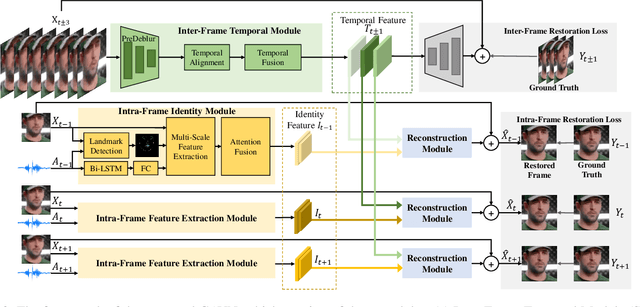
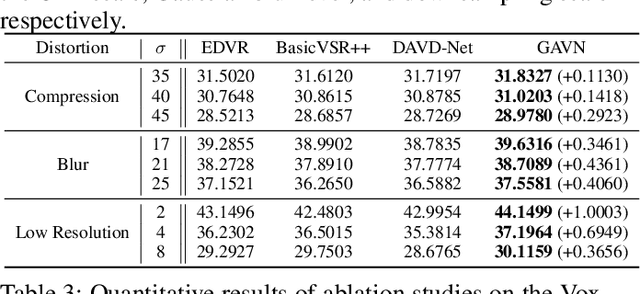
Face videos accompanied by audio have become integral to our daily lives, while they often suffer from complex degradations. Most face video restoration methods neglect the intrinsic correlations between the visual and audio features, especially in mouth regions. A few audio-aided face video restoration methods have been proposed, but they only focus on compression artifact removal. In this paper, we propose a General Audio-assisted face Video restoration Network (GAVN) to address various types of streaming video distortions via identity and temporal complementary learning. Specifically, GAVN first captures inter-frame temporal features in the low-resolution space to restore frames coarsely and save computational cost. Then, GAVN extracts intra-frame identity features in the high-resolution space with the assistance of audio signals and face landmarks to restore more facial details. Finally, the reconstruction module integrates temporal features and identity features to generate high-quality face videos. Experimental results demonstrate that GAVN outperforms the existing state-of-the-art methods on face video compression artifact removal, deblurring, and super-resolution. Codes will be released upon publication.
ClearerVoice-Studio: Bridging Advanced Speech Processing Research and Practical Deployment
Jun 24, 2025This paper introduces ClearerVoice-Studio, an open-source, AI-powered speech processing toolkit designed to bridge cutting-edge research and practical application. Unlike broad platforms like SpeechBrain and ESPnet, ClearerVoice-Studio focuses on interconnected speech tasks of speech enhancement, separation, super-resolution, and multimodal target speaker extraction. A key advantage is its state-of-the-art pretrained models, including FRCRN with 3 million uses and MossFormer with 2.5 million uses, optimized for real-world scenarios. It also offers model optimization tools, multi-format audio support, the SpeechScore evaluation toolkit, and user-friendly interfaces, catering to researchers, developers, and end-users. Its rapid adoption attracting 3000 GitHub stars and 239 forks highlights its academic and industrial impact. This paper details ClearerVoice-Studio's capabilities, architectures, training strategies, benchmarks, community impact, and future plan. Source code is available at https://github.com/modelscope/ClearerVoice-Studio.
FireRedTTS-1S: An Upgraded Streamable Foundation Text-to-Speech System
Mar 26, 2025In this work, we propose a high-quality streaming foundation text-to-speech system, FireRedTTS-1S, upgraded from the streamable version of FireRedTTS. FireRedTTS-1S achieves streaming generation via two steps: text-to-semantic decoding and semantic-to-acoustic decoding. In text-to-semantic decoding, a semantic-aware speech tokenizer converts the speech signal into semantic tokens, which can be synthesized from the text via a semantic language model in an auto-regressive manner. Meanwhile, the semantic-to-acoustic decoding module simultaneously translates generated semantic tokens into the speech signal in a streaming way via a super-resolution causal audio codec and a multi-stream acoustic language model. This design enables us to produce high-quality speech audio in zero-shot settings while presenting a real-time generation process with low latency under 150ms. In experiments on zero-shot voice cloning, the objective results validate FireRedTTS-1S as a high-quality foundation model with comparable intelligibility and speaker similarity over industrial baseline systems. Furthermore, the subjective score of FireRedTTS-1S highlights its impressive synthesis performance, achieving comparable quality to the ground-truth recordings. These results validate FireRedTTS-1S as a high-quality streaming foundation TTS system.
FlashSR: One-step Versatile Audio Super-resolution via Diffusion Distillation
Jan 18, 2025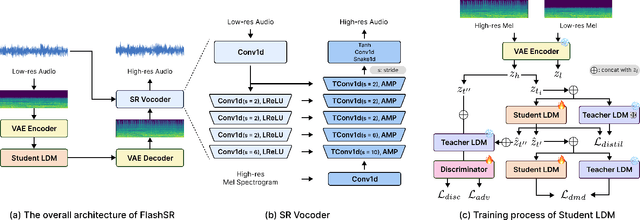
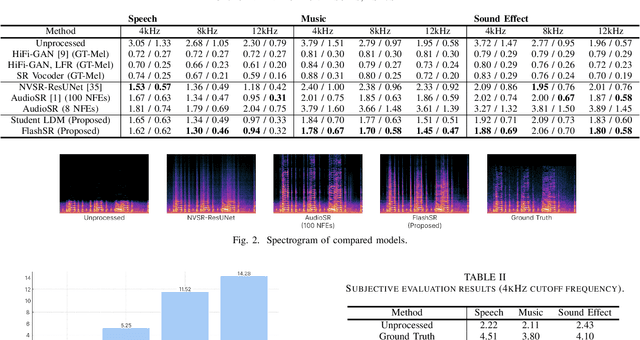

Versatile audio super-resolution (SR) is the challenging task of restoring high-frequency components from low-resolution audio with sampling rates between 4kHz and 32kHz in various domains such as music, speech, and sound effects. Previous diffusion-based SR methods suffer from slow inference due to the need for a large number of sampling steps. In this paper, we introduce FlashSR, a single-step diffusion model for versatile audio super-resolution aimed at producing 48kHz audio. FlashSR achieves fast inference by utilizing diffusion distillation with three objectives: distillation loss, adversarial loss, and distribution-matching distillation loss. We further enhance performance by proposing the SR Vocoder, which is specifically designed for SR models operating on mel-spectrograms. FlashSR demonstrates competitive performance with the current state-of-the-art model in both objective and subjective evaluations while being approximately 22 times faster.
FLowHigh: Towards Efficient and High-Quality Audio Super-Resolution with Single-Step Flow Matching
Jan 09, 2025



Audio super-resolution is challenging owing to its ill-posed nature. Recently, the application of diffusion models in audio super-resolution has shown promising results in alleviating this challenge. However, diffusion-based models have limitations, primarily the necessity for numerous sampling steps, which causes significantly increased latency when synthesizing high-quality audio samples. In this paper, we propose FLowHigh, a novel approach that integrates flow matching, a highly efficient generative model, into audio super-resolution. We also explore probability paths specially tailored for audio super-resolution, which effectively capture high-resolution audio distributions, thereby enhancing reconstruction quality. The proposed method generates high-fidelity, high-resolution audio through a single-step sampling process across various input sampling rates. The experimental results on the VCTK benchmark dataset demonstrate that FLowHigh achieves state-of-the-art performance in audio super-resolution, as evaluated by log-spectral distance and ViSQOL while maintaining computational efficiency with only a single-step sampling process.
AEROMamba: An efficient architecture for audio super-resolution using generative adversarial networks and state space models
Nov 11, 2024



Audio super-resolution aims to enhance low-resolution signals by creating high-frequency content. In this work, we modify the architecture of AERO (a state-of-the-art system for this task) for music super-resolution. SPecifically, we replace its original Attention and LSTM layers with Mamba, a State Space Model (SSM), across all network layers. Mamba is capable of effectively substituting the mentioned modules, as it offers a mechanism similar to that of Attention while also functioning as a recurrent network. With the proposed AEROMamba, training requires 2-4x less GPU memory, since Mamba exploits the convolutional formulation and leverages GPU memory hierarchy. Additionally, during inference, Mamba operates in constant memory due to recurrence, avoiding memory growth associated with Attention. This results in a 14x speed improvement using 5x less GPU. Subjective listening tests (0 to 100 scale) show that the proposed model surpasses the AERO model. In the MUSDB dataset, degraded signals scored 38.22, while AERO and AEROMamba scored 60.03 and 66.74, respectively. For the PianoEval dataset, scores were 72.92 for degraded signals, 76.89 for AERO, and 84.41 for AEROMamba.
AnyEnhance: A Unified Generative Model with Prompt-Guidance and Self-Critic for Voice Enhancement
Jan 26, 2025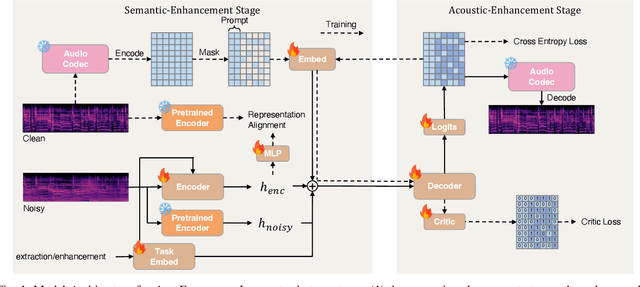
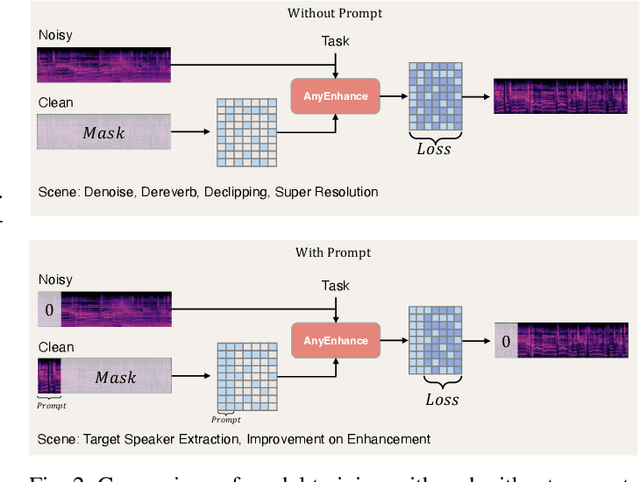


We introduce AnyEnhance, a unified generative model for voice enhancement that processes both speech and singing voices. Based on a masked generative model, AnyEnhance is capable of handling both speech and singing voices, supporting a wide range of enhancement tasks including denoising, dereverberation, declipping, super-resolution, and target speaker extraction, all simultaneously and without fine-tuning. AnyEnhance introduces a prompt-guidance mechanism for in-context learning, which allows the model to natively accept a reference speaker's timbre. In this way, it could boost enhancement performance when a reference audio is available and enable the target speaker extraction task without altering the underlying architecture. Moreover, we also introduce a self-critic mechanism into the generative process for masked generative models, yielding higher-quality outputs through iterative self-assessment and refinement. Extensive experiments on various enhancement tasks demonstrate AnyEnhance outperforms existing methods in terms of both objective metrics and subjective listening tests. Demo audios are publicly available at https://amphionspace.github.io/anyenhance/.
 Add to Chrome
Add to Chrome Add to Firefox
Add to Firefox Add to Edge
Add to Edge